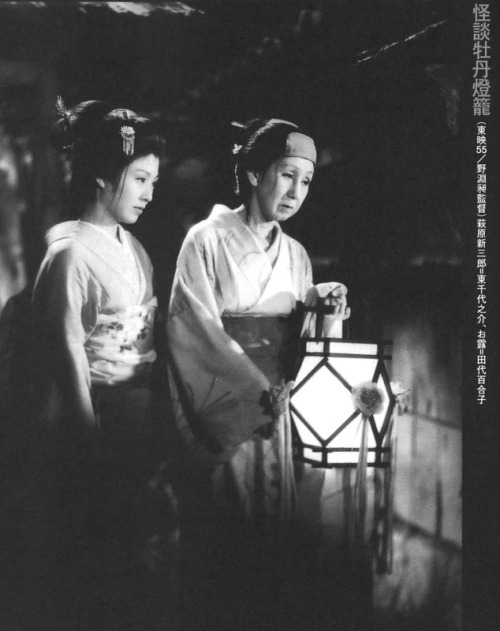Japan Folklore: Botan Dōrō
Botan Dōrō
The Peony Lantern
 Photo credits: allabout-japan.com
Photo credits: allabout-japan.com
There are many stories where unlucky lovers are separated by destiny that sometimes leads them to death together (Romeo and Juliet and Tristan and Isolde are the most famous). But none is like the story Botan Dōrō or The Peony lantern (牡丹 燈籠). Two lovers, divided by the world of the living and the world of the dead, are inextricably bounded by their oath of eternal love.
This legend sees the light in the book Jiandeng Xinhua written by Qu You during the first part of the Ming dynasty. Subsequently, it was revived during the Edo period by the Buddhist writer and priest Asai Ryōi on the wave of the Kaidan phenomenon (怪 談). This Japanese term refers to all those stories that tell of mystery and ghosts, written with two kanji: Kai (怪) that means “strange, mysterious, enchanted appearance” and Dan (談) “recited narration”.
This legend is recognized as one of the first Japanese stories about ghosts to become a movie in 1910. With numerous re-editions over the years, it is perhaps the most productive one among cinema, television adaptations and Pink Movie, Japanese Soft Porno genre.
The beautiful Otsuyu
 Photo credits: pinterest.com
Photo credits: pinterest.com
The legend says that during the first night of the Obon (the commemoration of the dead according to the Japanese Buddhist tradition) the samurai Ogiwara Shinnojo meets a beautiful woman and her child servant. The two hold in their hands the traditional lanterns of peonies and the samurai asks the child the name of the beautiful woman. Otsuyu was her name and the samurai is not able to do anything but fall madly in love and swear his eternal love for her that same night. From then on, the two meet every night burning with passion for each other. However, the beautiful woman and the child would always disappear before dawn. Because of this strange behavior, and also because of a sudden illness of the man, an old neighbor gets suspicious. Entering his house, he discovers that the samurai was not laying in bed with a beautiful woman but with a skeleton! The old neighbor then speaks with a priest who in turn warns Ogiwara that discovers that his beloved is actually a ghost. Ogiwara also understands that his illness is due to the fact that sleeping with a spirit consumes the vital energy of a person. The priest blesses the house of the samurai leaving protective spells and good luck charms so that the woman and the child cannot enter it anymore. The same evening the woman tries in vain to reach her beloved but, failing, desperately screams her love for Ogiwara, that eventually yields letting her enter the house. The next morning, the neighbor and the priest find Ogiwara dead clutching the skeleton of Otsuyu.
From the horror style of the Edo period to the romanticism of the Meiji period.
 Photo credits: tumblr.com
Photo credits: tumblr.com
The Kabuki version of this story is very famous, but there is a substantial difference between the two. In the theatrical versions, in fact, the protagonists know each other before the death of Otsuyu. Their families have been close for a long time and this had encouraged the birth of love between them. This version is the perhaps the most renowned one as it is pregnant with romance from beginning to end. Their love, the youthful passion, and then the frustration for a forced separation cause by the boy’s illness. During this period of separation Otsuyu dies believing that Saburo had not survived. But Saburo recovers and, desperate for the death of the girl prays to her spirit during the Obon festival. That same evening, he meets on his way home a woman and her servant holding a lantern of peonies. To his great joy, the young man realizes that the woman is his Otsuyu who, from that night on, will go visit him every night. But their joy will not last long. In fact, a servant, spying from a crack in the wall of Saburo’s room, realizes that in reality he lies every night with a skeleton. A Buddhist priest is immediately called and talismans are attached to the door of the house to prevent the spirit from entering. Yet, every night the girl returns to cry out her love for Saburo, who, desperate for the new separation, falls ill again. But the awareness of loving her anyway and despite everything means only one thing. Death! The talismans are removed to allow the spirit to enter once again. For the last time. However, the young protagonist dies happily in the arms of the one he loves.
This difference of themes can be attributed to the different periods in which the two versions were written. The original one dates back to the Edo period with the macabre vein that characterizes the Japanese folklore of the time. The theatrical one is more recent and sees the light in the Meiji period, the period in which Japan approaches the West thanks to the opening of Emperor Mutsuhito. Opening that did not occur only on a political level, but also on a cultural level thus influencing tastes and customs, and this legend is an example.[:]
Share this:
- Click to share on Facebook (Opens in new window)
- Click to share on Twitter (Opens in new window)
- Click to share on Tumblr (Opens in new window)
- Click to share on Pinterest (Opens in new window)
- Click to share on Telegram (Opens in new window)
- Click to share on WhatsApp (Opens in new window)
- Click to share on Reddit (Opens in new window)
- Click to print (Opens in new window)






